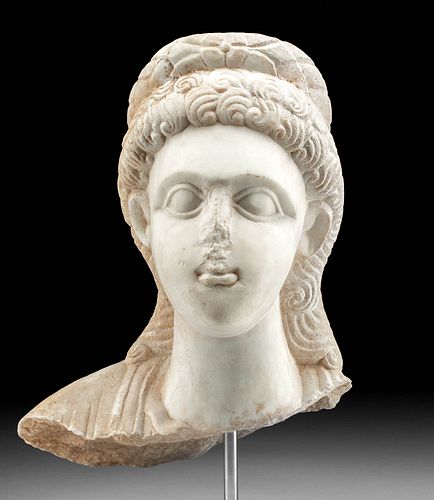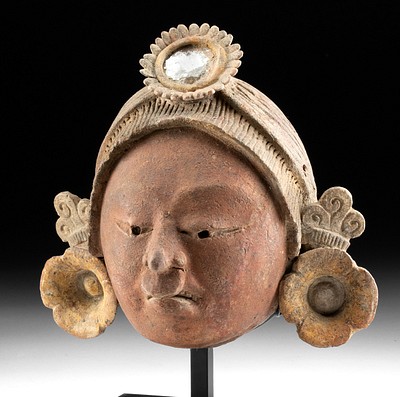Cypro-Archaic Marble Head of a Female Votary
Lot 13b
About Seller
Artemis Fine Arts
686 S Taylor Ave, Ste 106
Louisville, CO 80027
United States
Selling antiquities, ancient and ethnographic art online since 1993, Artemis Gallery specializes in Classical Antiquities (Egyptian, Greek, Roman, Near Eastern), Asian, Pre-Columbian, African / Tribal / Oceanographic art. Our extensive inventory includes pottery, stone, metal, wood, glass and textil...Read more
Categories
Estimate:
$8,000 - $10,000
Absentee vs Live bid
Two ways to bid:
- Leave a max absentee bid and the platform will bid on your behalf up to your maximum bid during the live auction.
- Bid live during the auction and your bids will be submitted real-time to the auctioneer.
Bid Increments
| Price | Bid Increment |
|---|---|
| $0 | $25 |
| $300 | $50 |
| $1,000 | $100 |
| $2,000 | $250 |
| $5,000 | $500 |
| $10,000 | $1,000 |
| $20,000 | $2,500 |
| $50,000 | $5,000 |
| $100,000 | $10,000 |
| $200,000 | $20,000 |
About Auction
By Artemis Fine Arts
Jul 14, 2022
Set Reminder
2022-07-14 10:00:00
2022-07-14 10:00:00
America/New_York
Bidsquare
Bidsquare : Exceptional Antiquities Ethnographica Fine Art
https://www.bidsquare.com/auctions/artemis-gallery/exceptional-antiquities-ethnographica-fine-art-9692
Museum-worthy examples of classical antiquities (Egyptian, Greek, Roman, Near Eastern), Viking, Far East / Asian, Pre-Columbian, African / Tribal, Oceanic, Native American, Spanish Colonial, Fossils, Ancient Jewelry, Fine / Visual Arts, so much more! Artemis Fine Arts info@artemisgallery.com
Museum-worthy examples of classical antiquities (Egyptian, Greek, Roman, Near Eastern), Viking, Far East / Asian, Pre-Columbian, African / Tribal, Oceanic, Native American, Spanish Colonial, Fossils, Ancient Jewelry, Fine / Visual Arts, so much more! Artemis Fine Arts info@artemisgallery.com
- Lot Description
Ancient Mediterranean, Cyprus, Cypro-Archaic to Cypro-Classical Period, ca. 6th to 5th century BCE. An exceptional marble sculpture of the head of a female votary, expertly sculpted in the round. Gazing forth from wide, almond-shaped eyes beneath a sweeping arched brow, the classic beauty boasts a sweet visage, featuring full cheeks and bowed lips, all supported by a long, elegant neck. An elaborate coiffure of intricately incised coils crowns her graceful head with several spiraling waves cascading down her neck and terminating just below her shoulders, which are covered by the folds of a himation. Her lavish locks are then surmounted by a thick, braided wreath or diadem with a rosette at the front. Size: 6.4" L x 8.8" W x 11.4" H (16.3 cm x 22.4 cm x 29 cm); 15" H (38.1 cm) on included custom stand.
According to the British Museum, "In 526/5 BC Cyprus suffered the same fate as the East Greek cites on the west coast of Asia Minor (modern Turkey). The island was absorbed into the Persian Empire which, since the fall of Babylon in 539 BC, had included Syria and Phoenicia. Freedom of movement within the Persian Empire intensified contact between these areas. Cypriot sculptors became more dependent on East Greek models and influenced by Phoenician taste." This melting pot of styles is perfectly exemplified in this piece. While the huge eyes, sharp brows, and rosette crown are all common tropes from eastern Greek art, the snake coils of the hair are demonstrative of Achaemenid (Persian) influence. Additionally, one can see clear Phrygian influence in the shape and angle of the eyes as well as the hair when compared to a marble head found in Gordion (4th image) in "The Legacy of Phrygian Culture" from Expedition Magazine issue 57.3 (2015).
Marble statues were quite rare for the Cypriots, as Cyprus does not have a local source of marble. Only the wealthiest individuals could afford to have works carved from marble that would have been quarried on the Greek islands. Thus, this sculpture was likely owned by a member of Cypriot nobility.
This piece has been searched against the Art Loss Register database and has been cleared. The Art Loss Register maintains the world's largest database of stolen art, collectibles, and antiques.
Provenance: East Coast collection, New York Gallery, New York City, New York, USA, acquired before 2010
All items legal to buy/sell under U.S. Statute covering cultural patrimony Code 2600, CHAPTER 14, and are guaranteed to be as described or your money back.
A Certificate of Authenticity will accompany all winning bids.
PLEASE NOTE: Due to recent increases of shipments being seized by Australian & German customs (even for items with pre-UNESCO provenance), we will no longer ship most antiquities and ancient Chinese art to Australia & Germany. For categories of items that are acceptable to ship to Australia or Germany, please contact us directly or work with your local customs brokerage firm.
Display stands not described as included/custom in the item description are for photography purposes only and will not be included with the item upon shipping.
#144094Fragment of a larger piece. Repair and restoration to chin and mouth. Losses to nose, as well as small area of loss on top of head. Some expected nicks, commensurate with age. Otherwise, excellent with impressive remaining detail and smooth surfaces.Condition
- Shipping Info
-
All shipping is handled in-house for your convenience. Your invoice from Artemis Gallery will include shipping calculation instructions. If in doubt, please inquire BEFORE bidding for estimated shipping costs for individual items.
-
- Buyer's Premium



 EUR
EUR CAD
CAD AUD
AUD GBP
GBP MXN
MXN HKD
HKD CNY
CNY MYR
MYR SEK
SEK SGD
SGD CHF
CHF THB
THB














